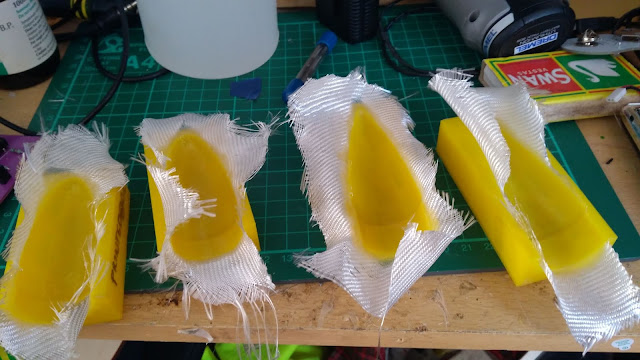So the last week or so I have been experimenting with designing and printing small PLA molds into which I can lay up fibreglass to create nosecones for rockets. In this post I plan to share the progress so far. Before we star though I wanted to explain a bit about why I want to create fibreglass nosecones. I have very successfully used 3d printed nosecones in all scales from the tiny ultra lightweight single wall nosecone I printed for my A impulse UK altitude holding record "Imp" rocket, through to larger nosecone for high power rocketry. Fibreglass/composite however is attractive as it is lightweight but also strong, and also only requires a thin shell whereas many 3d printed designs need thicker walls or indeed to be a solid infilled part. I'm also interested in building a minimum diameter 29mm rocket airframe to try and break Mach 1 and so I need a nosecone that maximises strength whilst remaining as hollow as possible to hold avionics inside when space in the airframe is so tight.
I printed a pair of mold halves using 0.2mm layer height and was reasonably pleased with the quality and surface finish of them. For the first and second attempt I did nothing to the 3d printed mold halves and left them in exactly the finish that they came off the printer. Although epoxy doesn't adhere *that* well to PLA I still wanted to use a release agent, but due to current lockdown, I had to try and use items I already had. I'd read online about someone using Glycerin as a release agent. The first attempt therefore I painted a thin coat of Glycerin onto the mold halfs before wetting them with laminating epoxy and adding some very very thin fibreglass cloth I have that is 40g/m weight. Its super thin and as such the next morning the mold halves had cured but the material was to fragile to pull from the mold without breaking it. Also I feel that the glycerin had failed as a releasing agent. I reprinted the mold halves again for a second attempt again with no post production/finishing and the same layer height.
This time I used some neutral shoe polish as a release agent applied by a finger very thinly. I was careful not to allow it to fill the corners where the nosecone shoulder sat and managed to get a neat uniform layer over it all. This time I went with some 110g/m cloth and laid up the mold halves seperately. Working at this small scale I had decided to try and make a single layer in both halves seperately with a margin of unglassed cloth left over and then I would do a second process to stick the two halves together with more epoxy and tape after trimming (hopefully) the first skin after it had cured.
Success, the next day the second attempt halves demolded pretty cleanly and although still flimsy showed that this could work (see top picture).

I trimmed the mold halves down as accurately as possible and then replaced them in the mold. I added a tiny smear of shoe polish to the mold half faces and then stuck the halves together with tape. At this scale it is pretty easy to get the mold halves to align, if I was working at a larger scale I would probably create keyed mold halves that interlock.
Having clamped the halves I then mixed another tiny amount of epoxy and added a strip of fibreglass cloth around the joint to stick the two halves together. It's difficult to work with such small amounts of such lightweight cloth through such a small aperture, but you don't have to be too precious as this will be on the inside of the nosecone so doesn't matter to much about the finish.
After this cured we could remove the nosecone and check it's fit in a piece of 29mm body tube, it fits perfectly! Once the nosecone is joined you can, of course add more layers internally to stiffen it etc. I added an extra layer inside and still this nosecone weighs less than 2.5g.
As a next stage I wanted to create a Von Karman Haack nosecone as that is probably the preferred geometry for my mach busting rocket idea. The original ellipsoid nosecone had picked up the details of the inside of the mold and the 3d printing layers were visible. Whilst I am happy these could be removed/smoothed out with sanding, filling, priming and painting it makes sense to minimise this work. As such I printed the Haack nosecone mold at 0.1mm layer height which increased the resolution of the finish and I spent some time sanding the inside of the mold to further enhance the finish.
I also wanted to comment that the molds are definitely reusable, any errant epoxy that sticks to the PLA can be scraped off whilst maintaining the mold surface, I remade another ellipsoid to the same finish using the same mold.
The Haack nosecone having been remolded has shown that printing at 0.1mm and trying to maximise the quality of finish on the mold is definitely worth doing. Whilst some sanding and smoothing will be needed the surface finish is generally very good on this one.
Finally, once I have a slightly larger collection of molds sorted I will release a repo with them all in over on www.openresearchrocketry.co.uk







No comments:
Post a Comment